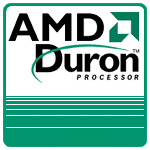 In
spite of the name change, the Duron is still based on the same Athlon design
that we were introduced to just less than one year ago. The reason for the
new name is so that AMD can clearly point those that aren’t as familiar with
CPUs as most of you all in the direction of the Duron if they want a low cost
system or an Athlon if they want the highest performance desktop system available
from AMD.
In
spite of the name change, the Duron is still based on the same Athlon design
that we were introduced to just less than one year ago. The reason for the
new name is so that AMD can clearly point those that aren’t as familiar with
CPUs as most of you all in the direction of the Duron if they want a low cost
system or an Athlon if they want the highest performance desktop system available
from AMD.
But of course, AnandTech readers know that “value” doesn’t necessarily have to mean slow, case in point being the incredible success we’ve had with Intel’s Celeron line of “value” processors which happen to be the Duron’s chief competitor.
In order to distance the Duron from the Athlon even more, it is only being released at three clock speeds, none of which overlap with currently available Athlon (Thunderbird) parts. The Duron will be available in 600, 650 and 700MHz frequencies and the Thunderbird picks up at 750MHz all the way up to 1GHz (and pretty soon, 1.1GHz).
Since the Duron is based on the Athlon, it still features the same 2-way set associative 128KB L1 cache that all Athlon based processors (K7, K75 & Thunderbird) have had. The Duron sets itself apart from the classic Athlon and the newer Thunderbird by the size of its L2 cache.
Like the Thunderbird, the Duron features a 16-way set associative on-die L2 cache running at the processor’s clock speed. The Duron differs in that instead of featuring a 256KB L2 cache it only has a 64KB L2 cache, or 1/4 the size of the Thunderbird and 1/2 the size of the Celeron’s L2 cache.
If you remember from our Thunderbird review, the on-die 256KB L2 cache of the processor increased the transistor count by a total of 15 million transistors from 22 million on the original K7 core up to a total of 37 million on the Thunderbird core. Since the Duron has 1/4 of the L2 cache of the Thunderbird you would expect it to have 1/4 as big of an increase in transistor count as the Thunderbird as well. Weighing in at 25 million transistors, the Duron features 3 million more transistors than the original K7 core, or 20% of the transistor increase of the Thunderbird.
As far as die sizes are concerned, we noticed an interesting phenomenon with the Duron. Let’s take a look at a quick comparison of the various die sizes:
|
CPU
Die Size Comparison
|
||||||||
| AMD Duron |
AMD
Athlon
|
|||||||
| Core |
Spitfire
|
K7
|
K75
|
Thunderbird
|
||||
| Die Size |
100mm^2
|
184
mm^2
|
102mm^2
|
120mm^2
|
||||
In order for the Duron to have a smaller die size than the K75 AMD must have done some reorganizing of the core because the Duron essentially has the same core plus an additional 64KB of integrated L2 cache. This confirms that the Duron and Thunderbird are much more than K75 cores with on-die L2 cache. AMD did quite a bit of optimization of the 0.18-micron layout with the two new cores. It is possible that AMD could have added another metal layer to the core much like Intel did with the Coppermine when they added a 6th metal layer.
|
CPU
Specification Comparison
|
||||||||
AMD Duron |
AMD
Athlon
|
Intel
Pentium III
|
Intel
Celeron
|
|||||
| Core |
Spitfire
|
K7
|
K75
|
Thunderbird
|
Katmai
|
Coppermine
|
Mendocino
|
Coppermine128
|
|
Clock Speed |
600
- 700 MHz
|
500
- 700 MHz
|
750
- 1000 MHz
|
450
- 600 MHz
|
500
- 1000 MHz
|
300
- 533 MHz
|
533
- 600 MHz
|
|
| L1 Cache |
128KB
|
32KB
|
||||||
| L2 Cache |
64KB
|
512KB
|
256KB
|
512KB
|
256KB
|
128KB
|
||
| L2 Cache speed |
core
clock
|
1/2
core
|
2/5
or 1/3 core
|
core
clock
|
1/2
core
|
core
clock
|
||
| L2 Cache bus |
64-bit
|
256-bit
|
64-bit
|
256-bit
|
||||
| System Bus |
100 MHz DDR
(200 MHz effective) EV6
|
100
- 133 MHz GTL+
|
66
MHz GTL+
|
|||||
| Interface |
Socket-A
|
Slot-A
|
Socket-A
Slot-A (OEM only) |
Slot-1
|
Slot-1
Socket-370 |
Socket-370
|
||
| Manufacturing Process |
0.18
micron
|
0.25
micron
|
0.18
micron
|
0.25
micron
|
0.18
micron
|
0.25
micron
|
0.18
micron
|
|
| Die Size |
100mm^2
|
184
mm^2
|
102mm^2
|
120mm^2
|
128mm^2
|
106mm^2
|
153mm^2
|
106mm^2
|
| Transistor Count |
25
million
|
22
million
|
37
million
|
9.5
million
|
28
million
|
19
million
|
28
million
|
|
Since the Duron has all of its cache on-die, there is no need for a processor card to place any L2 cache chips on, so it comes in the same 462-pin Socket-A packaging as the Thunderbird and will work in the same motherboards.
While the Thunderbird operates at a 1.70/1.75v core voltage (1.75v for 900MHz and faster parts), the Duron is running at 1.60v for the 600 - 700MHz parts because it has less cache to power.
| |










0 Comments
View All Comments